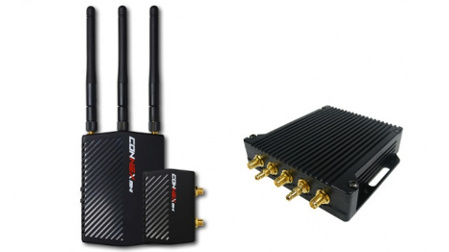The Missing Link: Where is RF for 4K?
LONDON—At the risk of restating the obvious, 4K is four times the size of 1080p video, which is a huge amount of data to transfer across a wireless link. The problem has been nominally solved in the sense that there are wireless 4K systems out there, but there's debate about the whether such systems are currently practical.

For Domo Tactical Communications (formerly Cobham) it’s all about making 4K production work - that is, to get it on a screen properly. Latency is the primary issue, especially for sports.
“Until the latency reduces, 4K will continue to be a challenge,” says Domo's broadcast sales director, JP Delport. “For example, if people are using H.265 algorithms to encode data, which on paper is 50 per cent more efficient than H.264, there’s still a heck of a lot of encoding going on, which by its nature increases latency. Until such point that Domo can provide the industry with a demonstrably usable 4K solution, we’re going to stick with 1080p. 4K can be done, and we’re working on it, but it will only be unveiled when it’s absolutely ready at the lowest possible, usable, latency."
There are a variety of ways to bring 4K to TV screens in the RF domain. Delport believes it will require the adoption of a new encoding algorithm, which will be H.265 or HEVC.
“If we want to do 4K in H.264 it’s possible that that amount of data could be modulated with our MIMO (multiple input/multiple output) technology over a wireless link. But it seems to me the obvious way to go is DVB-T2 with an H.265 encoder, which is where we are heading. Our current latency is one frame. Anything more than that would just not be suitable for 4K. Until we’re 100 per cent sure that we can have a 4K wireless camera at the side of a football field that has one frame or less of latency, there’s no point.”
The SOLO7-OB Tx camera-back transmitter is Domo's first 1080p60 solution. It has integrated camera control and swappable RF modules. It’s able to work at 4:2:2 chroma and does H.264/MPEG-4 AVC video encoding. Its latency ranges from 1s to an ultra-low 10ms and fits directly onto the back of an ENG type camera.
At this year's NAB this was demoed with a bi-directional link using MIMO IP Mesh technology firing 26 Mbit/s in combination with a Sony HDC-P1 camera mounted on a remote-controlled pan and tilt head. The unit takes HD-SDI from the camera, encodes the audio and video data to IP, and transmits it wirelessly to Domo’s MIMO IP Mesh system.
“Because IP Mesh provides an exceptionally high bit rate for bi-directional IP links, we can transmit A/V data one way while camera control and remote control data travels the other for control of pan and tilt, plus camera control data for colours, iris, etc. within the camera.”
Typically, this would require three separate frequencies, but with the SOLO8 SDR (pictured top right) and IP Mesh combination, it’s three data streams in a single bi-directional link, which makes the entire remote camera and control system completely wireless. This, claims Delport, is a genuine “first”.
COMPRESSION COMPLICATION
The data rate required to send 4K is about 19Gbps. “When you are trying to compress that amount of data, all the issues related to compression such as quality loss, added latency, and increase susceptivity to errors are increased dramatically,” says Uri Kanonich, vp of marketing at Amimon.
The firm's Connex technology doesn’t use regular compression, rather a unique video-modem solution. “This allows us to send today HD 1080P signals with less than 1ms latency and the same chipset will allow to do the same for 4K UHD,” says Kanonich.
The Connex mini is the latest addition to the Connex range (pictured top left). Unveiled at NAB, this is a ultra-small transmitter supporting 1080p, full HD wireless video at a range up to 1500ft, ideal for airborne drones as well as other unmanned systems.
“Drones require the support of both high range and transmitter robustness, adding to the already hard task of sending 4K. An additional critical parameter is the mobility of the drone,” says Kanonich. “The wireless link must be able to maintain the connection in all directions and while moving.”
Amimon previewed a solution for 4K straight from the lab. “The latency we are already able to present is practically zero, and the quality is just amazing,” claims Kanonich. “The unit's size we envision to be the size of the Connex mini. There's no need to increase size to support 4K UHD. But it will be next year before we launch it in actual products.”
BBC RESEARCH
BBC R&D's system is completely bespoke using relevant parts of DVB-T2, DVB-NGH and MIMO to maximise channel capacity.
“Having extra bit-rate allows for lower latency video coding,” says project engineer John Boyer. “The latency of the system is variable as interleaving can be dialled in by the user to improve link ruggedness, but the video coding is seven frames code/ decode delay. We expect future coder developments to reduce that delay.”
The UHD system uses extensions of an original HD version. “The new UHD system has additional advanced RF techniques, so we are expecting good performance and expectations are fuelled by range tests that we have done,” says Boyer.
BBC R&D is liaising with the industry to perform trials. ?
360 LIVE
Vislink is already providing what it says is the world’s first end-to-end wireless 4K/UHD live-video solution. The UltraLite module is designed for integration with existing UHD cameras, allowing customers to quickly and cost-effectively upgrade.
“We know that being wireless creates new and different points of view for the audience and allows the cameraperson flexibility when capturing action shots from different moving points,” says Ali Zarkesh, VP, product management, Vislink. “It allows the viewer to really be there, and now they can do all that with UHD”
Vislink’s system provides broadcasters with a simple upgrade path if they want to move to a 4K/UHD wireless live solution. The firm says they can upgrade existing cameras with the lightweight attachment that mounts onto a variety of 4K cameras and, with the UltraDecoder (on the receive side), they can use their existing wireless.
This story first appeared on TV Technology's sister publication TV Technology Europe.
Get the TV Tech Newsletter
The professional video industry's #1 source for news, trends and product and tech information. Sign up below.
Adrian Pennington is a journalist specialising in film and TV production. His work has appeared in The Guardian, RTS Television, Variety, British Cinematographer, Premiere and The Hollywood Reporter. Adrian has edited several publications, co-written a book on stereoscopic 3D and is copywriter of marketing materials for the industry. Follow him @pennington1

